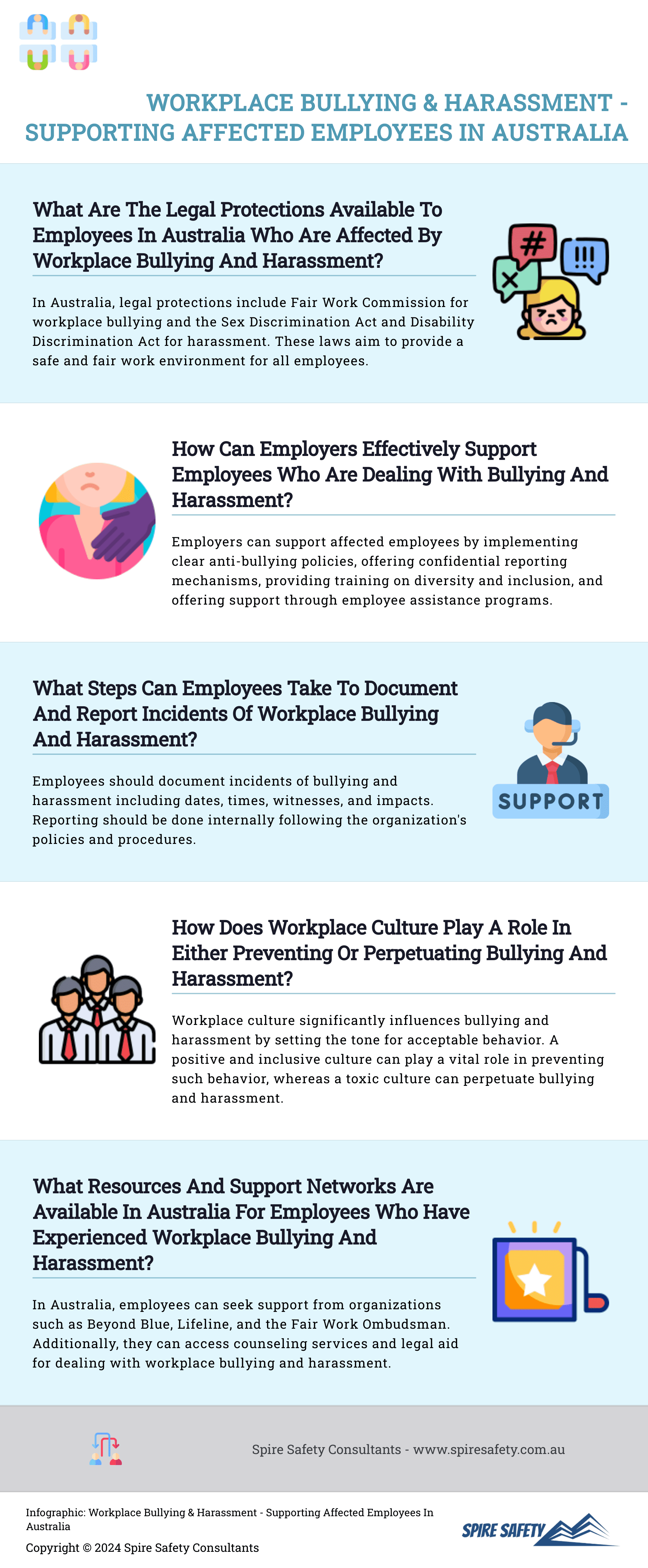Learn effective strategies for preventing and addressing workplace bullying and harassment in Australia.
Discover practical tips for creating a supportive work environment, developing comprehensive policies, providing employee support, and fostering a culture of respect.
Gain valuable insights and resources to support affected employees and promote a safe workplace.
Introduction
Workplace bullying and harassment can have devastating effects on individuals and organizations.
It is essential for employers in Australia to take proactive measures to prevent and address these issues effectively.
This article provides valuable strategies for supporting affected employees and creating a safe and respectful work environment.
By implementing comprehensive policies, fostering a culture of respect, and providing employee support, organizations can mitigate the impact of bullying and harassment.
Whether you are an employer, manager, HR professional, or employee, this article offers actionable tips and guidance to address workplace mistreatment.
Key Takeaways:
- Prevention and intervention strategies are crucial for addressing workplace bullying and harassment.
- Developing comprehensive policies and fostering a culture of respect are key elements in prevention.
- Providing support to affected employees is essential for their well-being and organizational success.
- Employee support and resources are available to address workplace bullying and harassment incidents effectively.

1. The Impact of Workplace Bullying and Harassment
Workplace bullying and harassment can cause significant harm to the affected individuals, their well-being, and the overall organizational culture. Understanding the impact of these issues is vital for prevention and intervention.
2. Creating Comprehensive Policies and Procedures
Developing comprehensive policies and procedures is a critical step in preventing workplace bullying and harassment. Consider the following elements when creating these policies:
2.1 Defining Bullying and Harassment:
- Clearly define bullying and harassment using legal definitions and examples.
- Ensure employees understand the behaviors that constitute bullying and harassment.
2.2 Outlining Reporting and Investigation Procedures:
- Establish clear reporting channels and procedures for employees to report incidents.
- Outline the process for handling and investigating complaints promptly and fairly.
2.3 Establishing Supportive Measures and Confidentiality:
- Provide resources for employees to seek support, such as counseling services or Employee Assistance Programs (EAPs).
- Assure employees of confidentiality and non-retaliation when reporting incidents.
2.4 Communicating Policies Effectively:
- Ensure policies are accessible to all employees, easily disseminated, and readily available.
- Conduct regular training sessions to educate employees on policies, expectations, and reporting procedures.
2.5 Regular Policy Review and Updates:
- Review policies regularly to ensure they align with legal requirements and industry best practices.
- Update policies when necessary and communicate changes to employees.
3. Fostering a Culture of Respect and Inclusion
Creating a workplace culture that promotes respect and inclusion is crucial for preventing workplace bullying and harassment. Consider these strategies:
3.1 Leading by Example:
- Leaders should set the tone for respectful behavior and cultivate an inclusive work environment.
- Demonstrate behaviors that embody the organization’s values and expectations.
3.2 Promoting Open Communication:
- Encourage employees to speak up about any concerns or incidents they witness or experience.
- Provide multiple channels for reporting and communication, ensuring confidentiality and non-retaliation.
3.3 Encouraging Diversity and Inclusion:
- Promote diversity and inclusion within the workplace, recognizing and celebrating individual differences.
- Embrace different perspectives, backgrounds, and experiences to foster unity and respect among employees.
3.4 Addressing Power Imbalances:
- Address power imbalances within the organization and ensure equitable treatment for all employees.
- Establish policies and practices that mitigate power differentials and foster a fair and inclusive workplace.
3.5 Recognizing and Celebrating Achievements:
- Highlight employees’ achievements and contributions, promoting a positive work environment.
- Celebrate diversity and recognize efforts to create an inclusive and respectful workplace.
3.6 Offering in-house Support Services:
- Provide access to support services within the organization, such as counseling or EAPs.
- Offer resources and assistance to employees who have been affected by bullying or harassment.
4. Promoting Awareness and Training
Raising awareness and providing training on workplace bullying and harassment is crucial for prevention. Consider these strategies:
4.1 Educating Employees on Bullying and Harassment:
- Conduct regular training to educate employees on the definitions and behaviors of bullying and harassment.
- Raise awareness about the impact these behaviors have on individuals and the organization.
4.2 Providing Guidance on Reporting Procedures:
- Communicate clear procedures for reporting incidents of bullying and harassment.
- Educate employees on the importance of prompt reporting and the protection of confidentiality.
4.3 Promoting Bystander Intervention:
- Encourage employees to intervene and support those experiencing bullying or harassment.
- Provide training on intervening safely and effectively to disrupt harmful behavior.
4.4 Training Managers to Address and Addressing Complaints:
- Train managers and supervisors to handle reports of bullying and harassment promptly and empathetically.
- Ensure they are aware of investigation procedures and their role in addressing complaints.
4.5 Reiterating the Organization’s Commitment:
- Reinforce the organization’s commitment to a respectful and safe work environment.
- Continuously remind employees of the procedures and resources available to them.
5. Supporting Affected Employees
Providing support to employees who have experienced bullying or harassment is crucial for their well-being and their reintegration into the workplace. Consider these strategies:
5.1 Encouraging Reporting and Confidentiality:
- Create a supportive environment where employees feel comfortable reporting incidents.
- Assure employees that their reports will be handled confidentially and without fear of retaliation.
5.2 Offering Counseling and Support Services:
- Provide access to counseling services, EAPs, or other support resources to affected employees.
- Offer individualized support to help employees navigate the emotional and psychological impact.
5.3 Facilitating Mediation and Conflict Resolution:
- Offer mediation services or facilitated discussions to resolve conflicts amicably.
- Create opportunities for affected employees and those involved to express concerns and find resolutions.
5.4 Providing Flexible Work Arrangements:
- Consider providing affected employees with flexible work arrangements, such as modified schedules or remote work, if appropriate.
- This flexibility can support their well-being and help them regain confidence.
5.5 Assisting with Career Development and Transitions:
- Support affected employees by providing avenues for career development and opportunities for growth.
- Help reestablish professional connections and assist in their transition within the organization if necessary.
6. Guidelines for Managers and Human Resources
Managers and HR professionals play a vital role in supporting affected employees and addressing workplace bullying and harassment. Consider these guidelines:
6.1 Responding Promptly and Empathetically:
- Respond to reports and complaints promptly, showing empathy and understanding towards affected employees.
- Create a safe space for them to discuss their concerns and fears.
6.2 Conducting Thorough and Fair Investigations:
- Follow a fair and unbiased process when conducting investigations.
- Collect and analyze evidence objectively, ensuring a comprehensive understanding of the situation.
6.3 Applying Appropriate Corrective Measures:
- Implement appropriate corrective actions based on investigation findings.
- Ensure disciplinary measures, when necessary, align with organizational policies and legal requirements.
6.4 Offering Ongoing Support and Follow-Up:
- Provide ongoing support to affected employees, checking in regularly and offering resources or additional counseling if needed.
- Follow up with affected employees to monitor their well-being and the effectiveness of implemented solutions.
7. Advice & Actionable Tips: Supporting Affected Employees
Supporting affected employees is crucial for their
well-being and recovery. Here are some actionable tips for providing effective support:
- Listen and show empathy: Create a safe space for affected employees to share their experiences and emotions. Listen actively and demonstrate empathy, validating their feelings and concerns.
- Offer counseling and mental health support: Provide access to professional counseling services or EAPs to help affected employees cope with the emotional impact of bullying and harassment.
- Facilitate peer support networks: Encourage affected employees to connect with others who have experienced similar situations. Peer support can provide a sense of validation, understanding, and solidarity.
- Provide resources and information: Offer resources such as articles, books, and videos on coping strategies, resilience building, and self-care. Ensure employees have access to information about their rights and avenues for reporting incidents.
- Implement security measures: If necessary, assess and enhance security measures to protect affected employees from any potential harm or retaliation. This may include updated access controls, ensuring confidentiality throughout the process.
- Review workload and responsibilities: Evaluate the workload and responsibilities of affected employees to ensure they have sufficient support during their recovery. Reallocate tasks or provide additional support to lighten their workload.
- Address workplace culture: Take steps to improve the overall workplace culture by reinforcing the importance of respect, empathy, and inclusivity. Encourage open dialogue and frequent feedback to foster a supportive environment.
- Monitor and follow up: Continuously monitor the well-being of affected employees and be proactive in offering ongoing support. Check in regularly and provide follow-up meetings to gauge their progress and ensure their needs are being met.
Remember, supporting affected employees requires a proactive and individualized approach. Each situation is unique, and tailoring support to their specific needs will contribute to their healing and reintegration into the workplace.
8. Key Resources for Addressing Workplace Bullying and Harassment
- Australian Human Rights Commission – https://www.humanrights.gov.au/
- Beyond Blue – Work and Mental Health – https://www.beyondblue.org.au/mental-health/work
9. FAQ Section
Q: What should I do if an affected employee is hesitant to report incidents of bullying or harassment?
A: Foster a trusting environment by emphasizing confidentiality, non-retaliation, and the organization’s commitment to addressing such issues. Encourage the employee to seek support from trusted colleagues or support resources.
Q: How can I ensure confidentiality when supporting affected employees?
A: Clearly communicate the measures in place to maintain confidentiality, such as sharing information on a strictly need-to-know basis. Assure affected employees that their privacy and confidentiality will be prioritized throughout the support process.
Q: Are there legal protections for employees who report bullying or harassment incidents?
A: Yes, Australia’s legal framework prohibits retaliation against employees who make a complaint or report incidents of bullying or harassment. Employers have a legal obligation to protect employees from any form of retaliation.
10. Conclusion
Supporting affected employees who have experienced workplace bullying and harassment is essential for their well-being and the overall health of the organization.
By implementing comprehensive policies, fostering a culture of respect and inclusion, providing support resources, and offering individualized care, employers can help affected employees heal and thrive.
Remember, support should be tailored to each employee’s needs, and ongoing monitoring and follow-up are vital to ensure their continued well-being and successful reintegration into the workplace.









